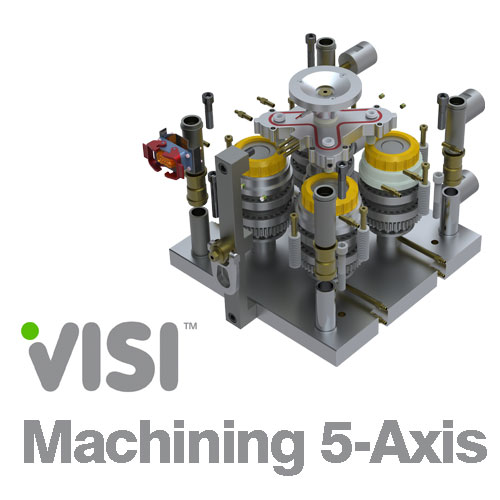Products
5 axis machining has traditionally been regarded as advanced technology best suited to the aerospace and automotive industry.
5 axis machining has traditionally been regarded as advanced technology best suited to the aerospace and automotive industry. 5 axis machining offers many advantages, all of which are now being applied to the mould and die sector. VISI Machining provides the operator with a productive solution for creating highly efficient toolpaths with advanced collision control for the most complex 3D data.
Features at a glance:
Extensive CAD interfaces
3D to 5 axis toolpath conversion
Continuous 5 axis roughing / finishing
3 + 2 positional machining
Multiple tool tilting options
Full gouge protection
Optimised toolpath movement
Kinematic simulation
Customisable postprocessors
HTML & XLS report output
Extensive range of CAD interfaces. VISI can work directly with Parasolid, IGES, CATIA v4 & v5, Pro-E, UG, STEP, Solid Works, Solid Edge, ACIS, DXF, DWG, STL and VDA files. The extensive range of translators ensures that users can work with data from almost any supplier. For complex 5 axis programming it is often necessary to tweak the geometry so companies working with complex designs will benefit from the simplicity with which their customer's CAD data can be manipulated.
Deep cavity / core machining. Many complex moulds contain deep cavity areas and small radii which need to be machined with small diameter tools. Generally this would involve the use of tool extensions or longer tools which would increase the risk of deflection and provide a poor surface finish. By approaching this from a different angle, the head can be lowered and the collision detection will automatically tilt the tool and holder away from the work piece. The major advantage of this strategy is the use of shorter tools which will increase tool rigidity, reducing vibration and deflection. As a result, a constant chip load and higher cutting speed can be achieved which will ultimately increase tool life and produce a high quality surface finish. In more shallow areas, larger bull nose cutters can be used with a small lag angle. The major advantage of this approach is a lower number of toolpath passes which also reduces machining time and improves surface finish.
3D > 5 axis conversion. All 3D toolpaths can be converted to 5 axis operations which dramatically increases the number of strategies available to cover any scenario. Using this approach will apply high speed machining technology to 5 axis toolpaths. The 3D > 5 axis conversion provides intelligent collision detection and will automatically tilt away from the piece only when required. This type of semi-automatic toolpath will dramatically speed up programming and shorten the learning curve.




